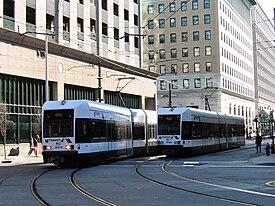Bayonne Flyer
| Hudson–Bergen Light Rail | |
|---|---|
 |
|

Passing trains near Exchange Place.
|
|
| Overview | |
| Type | Light rail |
| Status | Operating |
| Locale | Hudson County, New Jersey |
| Termini |
Tonnelle Avenue Hoboken Terminal 8th Street West Side Avenue |
| Stations | 24 |
| Services | 3 |
| Daily ridership | 54,434 (FY2014) |
| Operation | |
| Opened | April 2000 |
| Owner | New Jersey Transit |
| Operator(s) | Twenty-First Century Rail (AECOM and Kinkisharyo) |
| Character | Surface and elevated |
| Technical | |
| Line length | 17 mi (27.4 km) |
| Track gauge | 4 ft 8 1⁄2 in (1,435 mm) |
| Electrification | 750 V DC overhead lines |
The Hudson–Bergen Light Rail (HBLR) is a light rail system in Hudson County, New Jersey, United States. Owned by New Jersey Transit (NJT) and operated by the 21st Century Rail Corporation, it connects the communities of Bayonne, Jersey City, Hoboken, Weehawken, Union City (at the city line with West New York), and North Bergen.
The system began operating its first segment in April 2000, expanded in phases during the next decade, and was completed with the opening of its southern terminus on January 31, 2011. The line generally runs parallel to the Hudson River and Upper New York Bay, while its northern end and its western branch travel through the lower Hudson Palisades. HBLR has twenty-four stations along a total track length of just over 34 miles (55 km) and serves over 54,000 weekday passengers. There are plans for expansion through extensions and additional stations.
The project was financed by a mixture of state and federal funding. With an eventual overall cost of approximately $2.2 billion to complete its initial operating segments, the Hudson–Bergen Light Rail was one of the largest public works projects ever in New Jersey. The system is a component of the state's smart growth strategy to reduce auto-ridership and to revitalize older urban and suburban areas through transit-oriented development.
Hudson is the 6th most densely populated county in the U.S. and has one of America's highest percentages of public transportation use. During the 1980s and early 1990s, planners and government officials realized that alternative transportation systems needed to be put in place to relieve increasing congestion along the Hudson Waterfront, particularly in the vicinity of the Hudson River crossings. After extensive studies, it was decided that the most efficient and cost-effective system to meet the growing demands of the area would be a light rail system, constructed in several phases.
...
Wikipedia
